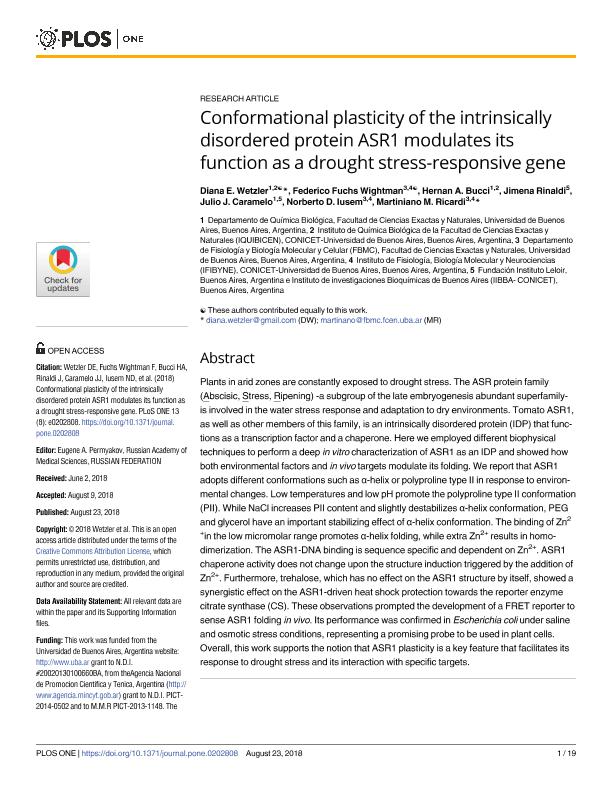Artículo
Conformational plasticity of the intrinsically disordered protein asr1 modulates its function as a drought stress-responsive gene
Wetzler, Diana Elena ; Fuchs Wightman, Federico; Bucci, Hernán Andrés
; Fuchs Wightman, Federico; Bucci, Hernán Andrés ; Rinaldi, Jimena Julieta
; Rinaldi, Jimena Julieta ; Caramelo, Julio Javier
; Caramelo, Julio Javier ; Iusem, Norberto Daniel
; Iusem, Norberto Daniel ; Ricardi, Martiniano María
; Ricardi, Martiniano María
 ; Fuchs Wightman, Federico; Bucci, Hernán Andrés
; Fuchs Wightman, Federico; Bucci, Hernán Andrés ; Rinaldi, Jimena Julieta
; Rinaldi, Jimena Julieta ; Caramelo, Julio Javier
; Caramelo, Julio Javier ; Iusem, Norberto Daniel
; Iusem, Norberto Daniel ; Ricardi, Martiniano María
; Ricardi, Martiniano María
Fecha de publicación:
08/2018
Editorial:
Public Library of Science
Revista:
Plos One
ISSN:
1932-6203
Idioma:
Inglés
Tipo de recurso:
Artículo publicado
Clasificación temática:
Resumen
Plants in arid zones are constantly exposed to drought stress. The ASR protein family (Abscisic, Stress, Ripening) -a subgroup of the late embryogenesis abundant superfamily-is involved in the water stress response and adaptation to dry environments. Tomato ASR1, as well as other members of this family, is an intrinsically disordered protein (IDP) that functions as a transcription factor and a chaperone. Here we employed different biophysical techniques to perform a deep in vitro characterization of ASR1 as an IDP and showed how both environmental factors and in vivo targets modulate its folding. We report that ASR1 adopts different conformations such as α-helix or polyproline type II in response to environmental changes. Low temperatures and low pH promote the polyproline type II conformation (PII). While NaCl increases PII content and slightly destabilizes α-helix conformation, PEG and glycerol have an important stabilizing effect of α-helix conformation. The binding of Zn 2 + in the low micromolar range promotes α-helix folding, while extra Zn 2+ results in homo-dimerization. The ASR1-DNA binding is sequence specific and dependent on Zn 2+ . ASR1 chaperone activity does not change upon the structure induction triggered by the addition of Zn 2+ . Furthermore, trehalose, which has no effect on the ASR1 structure by itself, showed a synergistic effect on the ASR1-driven heat shock protection towards the reporter enzyme citrate synthase (CS). These observations prompted the development of a FRET reporter to sense ASR1 folding in vivo. Its performance was confirmed in Escherichia coli under saline and osmotic stress conditions, representing a promising probe to be used in plant cells. Overall, this work supports the notion that ASR1 plasticity is a key feature that facilitates its response to drought stress and its interaction with specific targets.
Archivos asociados
Licencia
Identificadores
Colecciones
Articulos(IFIBYNE)
Articulos de INST.DE FISIOL., BIOL.MOLECULAR Y NEUROCIENCIAS
Articulos de INST.DE FISIOL., BIOL.MOLECULAR Y NEUROCIENCIAS
Articulos(IIBBA)
Articulos de INST.DE INVEST.BIOQUIMICAS DE BS.AS(I)
Articulos de INST.DE INVEST.BIOQUIMICAS DE BS.AS(I)
Articulos(IQUIBICEN)
Articulos de INSTITUTO DE QUIMICA BIOLOGICA DE LA FACULTAD DE CS. EXACTAS Y NATURALES
Articulos de INSTITUTO DE QUIMICA BIOLOGICA DE LA FACULTAD DE CS. EXACTAS Y NATURALES
Citación
Wetzler, Diana Elena; Fuchs Wightman, Federico; Bucci, Hernán Andrés; Rinaldi, Jimena Julieta; Caramelo, Julio Javier; et al.; Conformational plasticity of the intrinsically disordered protein asr1 modulates its function as a drought stress-responsive gene; Public Library of Science; Plos One; 13; 8; 8-2018
Compartir
Altmétricas



